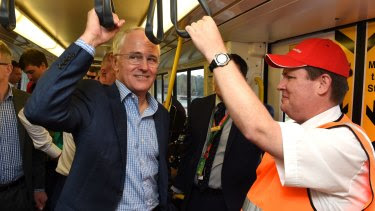
There are a number of folk getting quite excited at the prospect of some serious new investment in heavy commuter rail, as part of the Brisbane 2032 Olympics infrastructure legacy, but also with projects like Melbourne’s suburban rail loop. There’s no doubt that improved public transport connections are a good thing. But they can - in the case of heavy rail - be also very costly. The phrase “be careful what you wish for” seems apt.
The Moreton Bay (Redcliffe) line north of Brisbane serves as a recent and useful example of cost and commuter usage. None of what follows suggests it should not have been built. But the costs of the project, relative to its actual use by the community and the ongoing operational costs, are a reality the taxpayer is entitled to be aware of. If they’re unaware, politicians and consultants extolling the upsides should also be honest about the costs, because they are playing with other people’s (taxpayer) money.
Advertisement
The rail line to Redcliffe was first proposed in 1885. It was finally opened 130 years later in October 2016 (proof that trains really don’t run on time?) The line is a 12 kilometre extension of heavy gauge, dual track electrified commuter rail from Petrie to Kippa Ring.
The project cost $1.2 billion and includes six stations – Kippa Ring, Rothwell, Mango Hill East, Mango Hill, Murrumba Downs, and Kallangur. That’s $100 million per kilometre, including the stations, or $100,000 per metre of line distance covered.
According to Queensland Rail data, the total number of passengers boarding the line via the six stations in 2018 is a combined daily weekday average of 4,291. That was pre-Covid, and numbers broadly dropped by a third due to the pandemic. The pre-Covid numbers are a fairer representation of demand so we’ll use them.
The busiest station was Kippa Ring (989 people boarding daily), followed by Mango Hill (895) then Kallangur (703), Mango Hill East (672), Murrumba Downs (562) and Rothwell (470).
Assume that daily boardings are a proxy for the number of users (most people who board also disembark as it’s typically a return journey, and most people do this regularly for their commute). So assume it’s broadly the same 4,291 people using the line each day for commuting. There are also a small number using the line on weekends but this is unlikely to be for work so as a congestion buster, it doesn’t really qualify – heavy commuter rail is never justified as a weekend recreation service but as a weekday commuter service.
If the new line cost around $1.2 billion and is used by around 4,291 regular commuters, that’s a capital cost of $279,655 per passenger. That’s a big number.
Advertisement
Plus there’s the operational costs. Prior to Covid, the Queensland Government subsidy per rail passenger, per trip, was $21.15. (This number doubled when numbers fell in Covid). That subsidy is in addition to the train fare. So every time a passenger pays their fare, the taxpayer pays an additional $21.15. Per person, per trip. That’s $42.30 for a round trip, in addition to the fare.
(Buses were subsidised $4.02 per person per trip – a fraction of the cost of rail. Not only are buses much cheaper as public transport but they also make use of the existing road network, they can be re-routed in response to changing needs, and can be efficient with fewer passengers – none of which you can do with rail).
So for each of the 4,291 regular rail users on this line, the taxpayer is contributing an average $42.30 per day, or $211.50 per week per user. That’s $907,546 in total per week for all users. Call it a million dollar rail fare subsidy per week for travellers on this line alone.
Discuss in our Forums
See what other readers are saying about this article!
Click here to read & post comments.
7 posts so far.